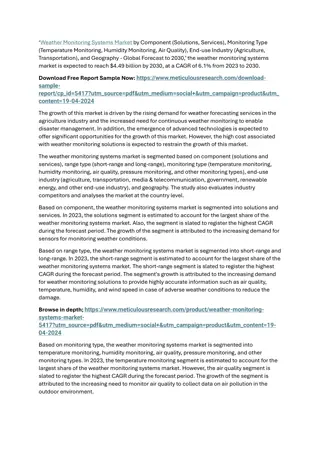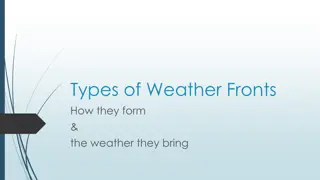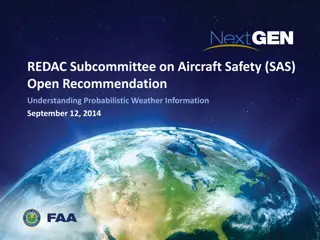Weather Map Interpretation
Weather maps provide data on various weather elements at a specific time. They show isobars, wind direction, cloud cover, rainfall, and more. Weather maps differ from synoptic charts which provide additional detailed information. Analyzing weather maps helps predict weather trends.
6 views • 7 slides
The Surface Weather Map
Surface weather maps, symbols, and their meanings. Discover how to interpret weather features and map lines for weather predictions. Learn the efficient plotting of data on maps.
1 views • 11 slides
Week at A Glance for Science
The sun, land, and water affect climate and weather. Analyze Earth's atmospheric layers, energy transfer processes, wind systems, and meteorological events. Investigate the sun's heat transfer and its influence on air, land, and water. Learn about air pressure, weather fronts, and the effects of oce
3 views • 9 slides
Weather Monitoring Systems Market 2
The increased need for continuous weather monitoring to enable disaster management and the rapid weather fluctuations and climate changes drive the growth of this market. In addition, the increasing adoption of sensors for weather monitoring and the emergence of advanced technologies are expected to
8 views • 2 slides
Understanding CAPE and CIN Calculation in Atmospheric Modeling
Learn how to calculate Convective Available Potential Energy (CAPE) and Convective Inhibition (CIN) using the Weisman-Klemp sounding method. The procedure involves defining parcel properties, lifting the parcel level by level, and performing saturation adjustments. Explore the concepts of positive a
0 views • 14 slides
Understanding the Impact of Weather on Daily Life
Weather plays a crucial role in our everyday lives in various ways. From influencing our activities to affecting our mood, the weather can impact us significantly. Understanding how weather elements like temperature, humidity, air pressure, and precipitation influence our routines is essential for a
1 views • 27 slides
Understanding Air Masses, Fronts, and Severe Weather in Earth Science
In Chapter 20 of Earth Science, we delve into the dynamics of air masses, fronts, and severe weather. Meteorologists study the movement and characteristics of air masses to predict weather changes. Air masses, defined by their temperature and humidity, interact at fronts, leading to precipitation an
0 views • 7 slides
Exploring Weather through Infrared Temperature Detection
Studying everyday weather using infrared temperature detection from the environment can help in understanding the relationship between temperature variations of different objects and weather conditions. This activity involves creating hypotheses and testing them using an infrared temperature sensor.
0 views • 20 slides
Exploring 2nd Grade National Geographic: Weather, Tools, and Natural Disasters
Dive into the fascinating world of weather phenomena with 2nd-grade National Geographic resources. From predicting weather using clouds to learning about thunderstorms, hurricanes, and tornadoes, this educational journey also covers weather tools and being prepared for natural disasters.
0 views • 15 slides
Interactive Learning Activities for Weather Pattern Exploration
Engage students in fun activities like listening and drawing games, exploring weather proverbs, and practicing grammar with weather-related examples. Learn about weather patterns and how to inquire about the weather in English while enhancing language skills.
0 views • 12 slides
Weather Alert System and Carline Procedures
Thor Guard Lightning is a lighting alert system that provides visual and auditory signals for different weather conditions. Severe weather such as storms or lightning can trigger alerts, leading to specific actions like taking cover or seeking safety indoors. During inclement weather, students and t
0 views • 4 slides
Comparison of Convective Cores in Gulf and Plains Regions
A detailed comparison of convective cores between Gulf and Plains regions across different seasons reveals interesting patterns. Gulf storms have more cores in the fall, with larger sizes and more cores in winter. The Plains see more cores in the spring season and have generally bigger storms year-r
1 views • 4 slides
Analysis of Seasonal Variations in Gulf Plains Convective Cores
The analysis reveals fascinating insights into Gulf Plains convective cores, showcasing variations in core numbers, average pixels per storm, pixels per core, and core sizes across different seasons. Deep-Wide cores dominate in the summer, while Gulf cores are larger in the fall. The study sheds lig
1 views • 4 slides
Exploring Weather Phenomena and Meteorological Predictions
Dive into the fascinating world of weather phenomena and the science behind meteorological predictions in this unit of Living By Chemistry SECOND EDITION. Learn about proportional relationships, temperature scales, behavior of gases, and how to interpret weather maps to make accurate predictions. En
0 views • 19 slides
Cold Weather Pit Count Coordinator Module 3 Planning for Success
Cold weather presents challenges for conducting pit counts to address homelessness. Visibility of homelessness decreases in cold weather, making locating individuals more challenging. Planning ahead with contingency dates, volunteer coordination, and route planning is crucial for success in cold wea
0 views • 11 slides
Mainstreaming Weather and Climate in Radio Discussions
Weather and climate significantly influence various aspects of our lives, from our daily activities to business operations and food supply. This content discusses the importance of incorporating weather and climate discussions in radio broadcasts, emphasizing their impact on health, agriculture, bus
1 views • 19 slides
Unstable Weather Alert: Tropical System Impact and Shear Line Approaching
Tropical system passing north, bringing heavy rainfall and unstable air. Expect convective showers, tailwinds on landing, and shifting precipitation patterns. Concerns about tropical showers, moisture levels, and shear line impact on landing and takeoff conditions. Images of weather situations provi
1 views • 10 slides
Understanding Weather Fronts: How They Form and Impact Weather Patterns
Weather fronts, including cold fronts, warm fronts, stationary fronts, and occluded fronts, play a crucial role in influencing weather patterns. Cold fronts bring quick storms with heavy rain and thunder, while warm fronts lead to gentle rain followed by milder weather. Stationary fronts result in p
0 views • 17 slides
Understanding Weather: Describing and Observing Weather Patterns
Exploring the fundamentals of weather observation and description, this lesson highlights the importance of using our senses to assess weather conditions such as temperature, wind, and precipitation. Students are encouraged to actively engage with their environment to describe the weather accurately
0 views • 10 slides
Detailed Overview of a Radiative-Convective Model for Weather Prediction
This detailed overview explores the components of a Radiative-Convective Model, covering convection, radiation transfer, cloud-radiation interaction, and surface fluxes. The model incorporates algorithms and parameterizations to simulate various cloud types, radiative transfer processes, and surface
1 views • 9 slides
Convection Parameterization for Low-CAPE Environments
Many global Numerical Weather Prediction systems face challenges predicting convective activity in low-CAPE environments. This study introduces a convection parameterization scheme based on moisture convergence to better represent convective effects. The scheme focuses on the triggering function, up
1 views • 38 slides
Weather Derivatives and Risk Management in Utilities
Explore the impact of weather on businesses, specifically utilities, and how weather insurance products can help mitigate risks. Learn about Pacific Northwest Electric's challenges in the face of changing weather patterns and the use of weather protection products. Discover the utility lingo, possib
0 views • 9 slides
Conceptual Model for Hydrometeor Structure of Mesoscale Convective Systems during MJO Active Stage
This study presented a conceptual model for characterizing the hydrometeor structure of Mesoscale Convective Systems (MCSs) during the Madden-Julian Oscillation (MJO) active stage. The research focused on the kinematic structure of MCSs and utilized radar data, compositing methodology, and convectiv
1 views • 24 slides
Comparison of Extreme Weather Events in Different Seasons
An analysis of extreme weather events across spring, summer, and autumn, focusing on core aspects per storm, average pixels per storm, and stratiform versus convective distribution. The comparison provides insights into variations in weather patterns and intensity across the seasons.
0 views • 30 slides
Analysis of Cloud-Resolving Simulations Over Complex Terrain
Examining cloud-resolving simulations of moist convection over complex terrain using large eddy simulation (LES) and deep convective fluxes. The study includes characteristics of the simulations, numerical convergence, and turbulent diffusion. Results reveal insights into the behavior of convective
0 views • 20 slides
Understanding Air Masses and Fronts in Weather Systems
Air masses play a crucial role in weather patterns, characterized by temperature and moisture content. They form over specific regions and influence weather conditions when they interact at fronts. Fronts are boundaries between air masses, such as cold fronts, warm fronts, occluded fronts, and stati
0 views • 17 slides
Understanding the National Weather Service Valid Time Event Code (VTEC)
Explore the evolution of the National Weather Service Valid Time Event Code (VTEC) system introduced in 2005 by Daryl Herzmann at Iowa State University. Learn about the importance of VTEC in weather alerts and how it revolutionized the dissemination of critical weather information. Dive into example
0 views • 10 slides
Evolution in Identifying High-Impact Weather Events since February 1979
Evolution in identifying high-impact weather events since 18-19 February 1979 discusses the advancements in identifying significant weather events. The article highlights the influence of standardized anomalies in recognizing features associated with extreme weather, aiding in the accurate identific
0 views • 22 slides
Understanding Weather Patterns for Predictions
Explore how weather patterns in different locations influence predictions as you review weather data for Detroit and Pomona in January. Learn to make claims about where and when a story takes place using evidence from weather calendars and graphs. Enhance your understanding of weather observation an
0 views • 17 slides
Severe Weather Project Summary for Week 34
Week 34 of the Severe Weather Project focused on expanding development and evaluation of severe weather potential model guidance. The project aimed to develop experimental forecast tools for severe weather at Week 3-4 time range, utilizing a hybrid model and SCP (Supercell Composite Parameter). The
0 views • 21 slides
Extreme Weather Events Comparison in Different Seasons
This dataset contains detailed comparisons of extreme weather events in Spring, Summer, and Autumn for different types of convective cores and stratiform regions. The data includes information on average pixels per storm, cores per storm, and stratiform versus convective ratios across the Plains and
0 views • 30 slides
Understanding Weather Station Data and Atmospheric Pressure Basics
Explore essential concepts in meteorology including weather station instrumentation, atmospheric pressure determination, weather map basics, and isotherm plotting. Learn about interpreting weather station models, identifying pressure systems, and understanding isotherms for temperature analysis on w
0 views • 5 slides
Progress Towards a Quality-Controlled Historical Weather Data Platform
Comprehensive development progress towards a quality-controlled historical weather data platform led by Dr. Grace Di Cecco, focusing on the challenges of accessing and aggregating weather observations from various sources and the project's goals of cleaning, aggregating, and standardizing hourly wea
0 views • 21 slides
Understanding Weather Impact on Drones and Aircraft Performance
Delve into the influence of weather conditions on drones and aircraft operations. Explore different types of drones, sensors, and aircraft performance in various weather scenarios. Discover how wind, visibility, and FAA tests affect flight safety. Learn about sources of weather information like META
1 views • 23 slides
Understanding Coupling of Convective Motions and Cloud Macrophysics in Climate Model CMDV-CM4
This project led by Lawrence Berkeley National Laboratory aims to mechanistically couple convective motions and cloud macrophysics in the CMDV-CM4 climate model. Through observational techniques and parameterization development, they seek to evaluate and enhance current cloud representations, develo
0 views • 16 slides
Geography Homework Booklet - Weather and Climate Study
A comprehensive geography homework booklet focused on understanding weather and climate topics, covering concepts such as the key differences between weather and climate, forecasting weather conditions, reasons for tropical storms losing energy, and the UK's experience with extreme weather events. S
0 views • 6 slides
Understanding Air Masses in Weather Prediction
Air masses play a crucial role in weather patterns. They are large bodies of air with consistent temperature and humidity characteristics. Different types of air masses, such as Continental Polar and Maritime Tropical, influence weather conditions based on their properties. Weather fronts form where
0 views • 9 slides
Norton City Schools Inclement Weather Plan 2023-2024
The Norton City Schools' Inclement Weather Plan for 2023-2024 outlines procedures for decision-making during severe weather conditions, including the use of altered schedules, remote learning days, and early dismissals. The plan includes detailed steps for monitoring road conditions, checking weathe
0 views • 18 slides
Understanding Probabilistic Weather Information in Aircraft Safety Recommendations
Subcommittee on Aircraft Safety (SAS) emphasizes the importance of understanding probabilistic weather information for better operational decisions in aviation. Recommendations include leveraging existing knowledge and conducting studies to improve user understanding and decision-making processes re
0 views • 12 slides
School Weather Alert System Procedures
A detailed overview of the school's weather alert system including Thor Guard lightning alerts and procedures for inclement weather conditions. It covers the different states of detection, horn signals, and actions to be taken during severe weather. The protocol for handling inclement weather, excep
0 views • 4 slides







































